NATIONAL - Shades of Amber - Hemingray Jewels
Reprinted from "Crown Jewels of the Wire", September 2000, (Insert) page 8
Bob Stahr, St. John, Indiana
NIA Award for Color
According to some definitions, the color amber is "yellow or yellowish
brown". When it comes to Hemingray, amber can mean a lot of things. There are
at least a dozen distinct colors of CD 162 H.G.Co. signals. In addition, you can
add in descriptors of olive, yellow, orange, red and adjectives like dark and
light. With these combinations, the list is almost endless. Since Hemingray was
producing tableware, lamps, bottles and fruits jars in amber, it stands to
reason that there would be production of all of these from the same glass batch.
In fact, there are uncanny color matches between some insulators and the other
products Hemingray made.

Bob says: I have been collecting insulators for a total
of 11 years, specializing in Hemingray insulators for 9 years, and collecting
the Hemingray "go-withs" for the last 5 years.
Over the years when I
was collecting insulators in general, I would say people like John McDougald and
Elton Gish were mentors in some fashion. When it comes to Hemingray and
especially the Hemingray go-withs; there was really no one. I have been
conducting my own research and have learned everything myself, becoming a mentor
to others.
|
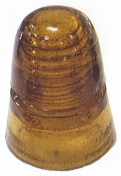
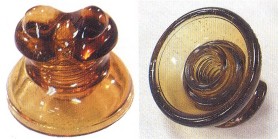
|
Two favorite insulators from collection include the amber CD 145 H.G.Co.
Petticoat beehive and the CD 230 Hemingray D-512 in a swirling multi-toned
amber. |
Well, most of the insulators in my display were bought at earlier
shows or acquired through the purchasing of other collections. There isn't any
special story behind these that I can think of. However, there is an interesting
story behind one of my lamps though. As many of you know, I have been to the Behringer-Crawford Museum in Covington, KY that
owns the artifacts from the archaeological dig of the Hemingray factory site
there. Back in June of 1997, I borrowed many of these shards to bring to the
1997 Chicago National. On my trip home with these shards I stopped at a few
antique shops along the way. In one display case, appeared a footed finger lamp in
amber. The base looked familiar, but I wanted to be sure. So, now I am out in
the parking lot sorting through boxes to find the shard. After finding a
depression green shard, I went back inside and matched it up perfectly with the
amber one. Since that time, I have found at least 4 more lamps in that very same
shop.
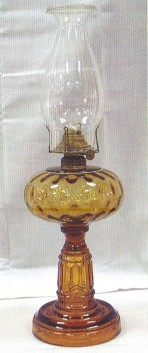
The amber oil lamp pattern is called Inverted
Thumbprint & Prism Stem. I
have a matching
set of these in the Orange amber pictured,
Peacock Blue,
Depression Green, and Clear
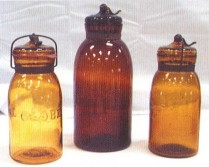 |
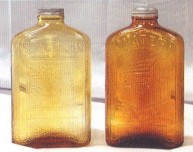 |
| The three Globe jars represent two sizes and three distinct colors. The
darkest one is a half gallon in dark brown amber. The other two are quarts in
light orange amber and a honey amber shade. These are all towards the extreme
shades and are in some cases much more valuable then a regular amber. |
The water bottles are both marked with the Owens-Illinois logo and the
Hemingray name blotted out. These were made in 1935 and were likely the last
water bottles produced at that factory. Amber and 7-up green beer bottles would
be produced there in the early 1940's. I know of less than 10 of these amber water
bottles in collections. |
 |
The two bird dishes, patented by Hemingray in 1876 come in several colors.
These two represent the extreme shades of amber. One is almost yellow and the
other is a nice orange amber. |
| The almost black dark amber beer bottle is marked HGCO on the bottom. These
were made in the late 1870's to early 1890's. |
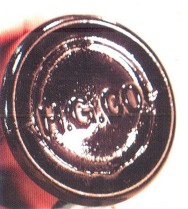 |
I have so many favorites in this display, it would be very difficult to rule
out a single item. I guess you could say I brought my favorites from each
category of Hemingray s production. The light yellow amber bird dish that was
patented by Hemingray in 1876 would be one of the top items.
The top want for me
right now is paper documentation on Hemingrays total production. I have just
recently acquired a catalog page from 1892 showing many Hemingray lamps. Also, I
just purchased a ca. 1882 catalog of Hemingray Decorated Opal Shades. Now I am
on the lookout for these shades (over 20 patterns, for a total of 194 variations
of production). Tableware documentation is coming along slowly, as is early
bottle and specialty jar production. Interestingly enough, during digs performed
at the Muncie factory site, additional insulator styles, colors, and embossings
can now be attributed to Hemingray as well.

Bob Stahr
|
